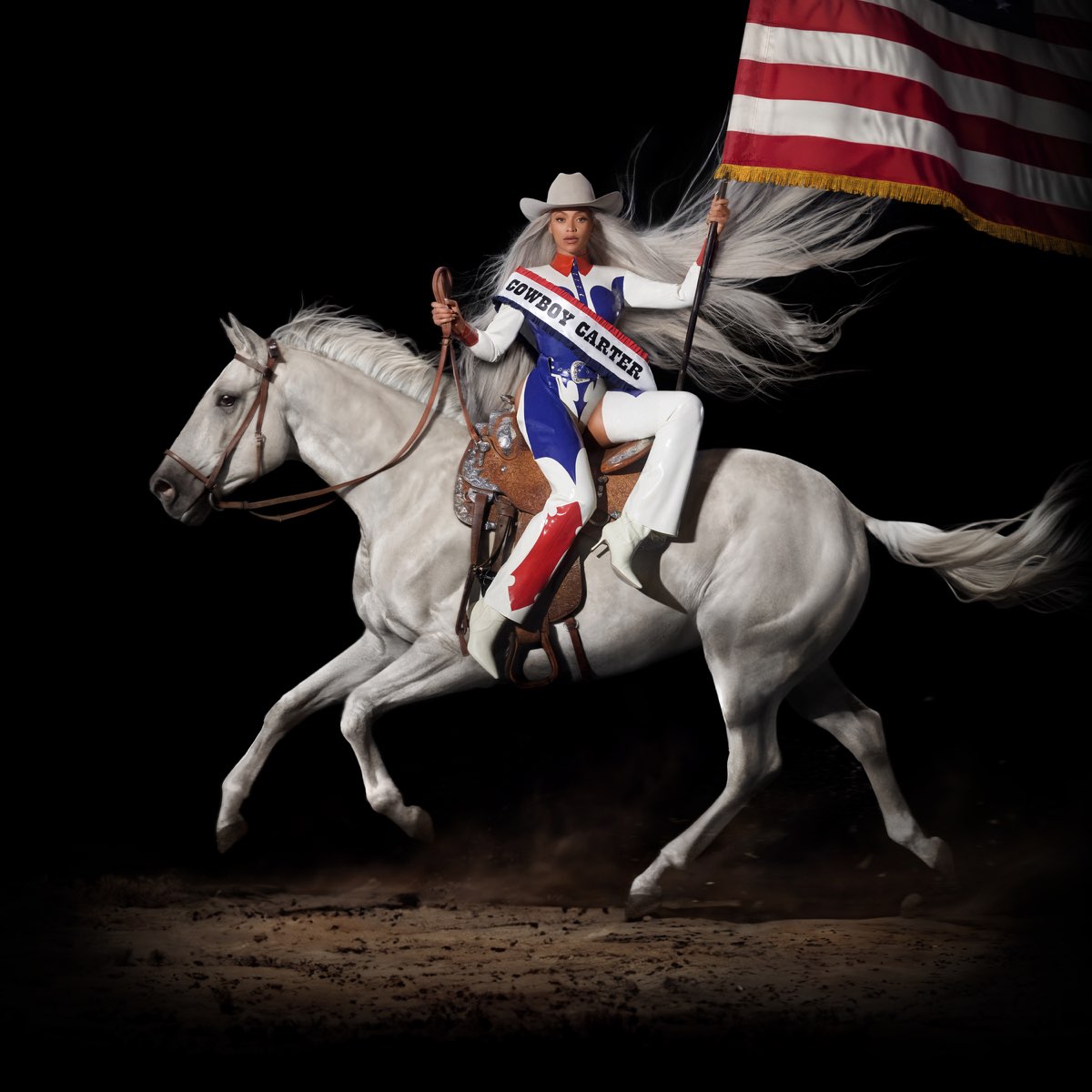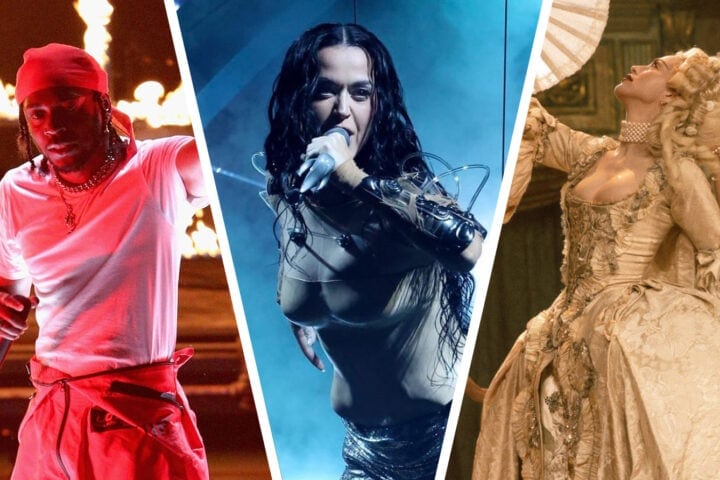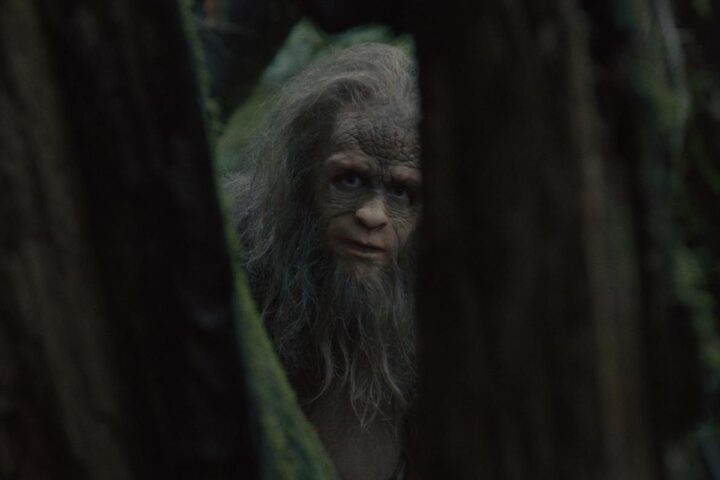A decade into her solo career, Beyoncé effectively evaded irrelevancy by wresting control of her own narrative. After her 2011 album 4 failed to produce a Top 10 hit—to date, her only album to do so—the singer began dropping albums without any pre-release promotion, sidestepping chart expectations and reimagining the traditional pop album release strategy. Since then, she’s done few interviews and often glides into awards shows donning dark shades and a straight face, shrewdly creating a superstar mystique in the vein of Michael Jackson and Prince.
That approach, thankfully, has been accompanied by some of Beyoncé’s most creative, political, and inspired work to date. Her 2016 visual album Lemonade drew on her personal experiences as a Black woman to comment on feminism and racism in the Me Too and Black Lives Matter era, while its follow-up, 2022’s Renaissance, kept the focus squarely on the music, inspired by and dedicated to the innovators of queer ball and club culture.
With Cowboy Carter, Beyoncé continues her journey through America’s musical past—and present—and has prompted a deeper, if not always civil, conversation about what cultural appropriation means. To celebrate, we’ve ranked all eight of the singer’s studio albums. Sal Cinquemani
Editor’s Note: This article was originally published on June 21, 2023.
8. I Am…Sasha Fierce (2008)
Most memorable for its hit singles, the early meme-maker “Single Ladies (Put a Ring on It)” and the bleacher-stomping power ballad “Halo,” the songs on I Am…Sasha Fierce are divided into two discrete parts: slow jams of a purported personal nature and more aggro club tracks attributed to the doppelganger of the album’s title. It’s a momentum-killing formula that makes for not only a disjointed listening experience, but an incoherent narrative. The album is more eclectic than its predecessors, with some surprisingly subtle ballads (“Disappear” and “Satellites”) and deliciously odd bangers (“Diva” and “Video Phone”). But in the end, Beyoncé’s alter ego isn’t really much different from the artist we’d come to know. The real disparity on I Am…Sasha Fierce is Beyoncé’s inability to reconcile the adult-contemporary schmaltz of the album’s first half with the more modern, edgy sounds of its second. Cinquemani
7. Dangerously In Love (2003)
Beyoncé’s Dangerously In Love accomplished what every successful debut album should: It cemented the notion that the singer was a formidable solo star, if that was ever in doubt, with a series of infectious pop hits (“Crazy In Love,” “Naughty Girl,” and “Baby Boy”). It also gave her latitude to flaunt her vocal prowess (“Me, Myself and I”) and explore more mature themes (“Speechless”) and sultry R&B sounds (“Be with You”) without straying too far from the template established by Destiny’s Child. The album doesn’t attempt to reinvent the wheel (though it did introduce the go-go subgenre to the masses), nor does it succumb to the tropes of the era (despite guest appearances from a bevy of hip-hop heavyweights, including Jay-Z, Big Boi, and Missy Elliott). If the album’s second half drags, that’s in part because it does follow one tired trend by stacking its fire bops at the top. That said, you can’t blame her record label for wanting to re-introduce their new Queen Bee with a buzz. Cinquemani
6. 4 (2011)
The predominately intimate, ballad-heavy 4 found Beyoncé fertile and ready. From the opening lines of the crushing “1+1,” the singer’s voice is ripe and, well, full-bodied, and the glow continues through the climax of the album’s first single, “Run the World (Girls).” The tracklist isn’t so much filled with baby-making jams as it is populated by little R&B fetuses, and Beyoncé’s voice is the midwife. Beyond “Run the World” and “Love on Top,” a bright, breezy tribute to the freshness of mid-’80s R&B, the album is otherwise dominated by mid- to no-tempo tracks, which, vocally speaking, gives Bey enough rope to hang either her doubters or herself. Fittingly, during a performance of “Love on Top” at the VMAs a few months after the album’s release, she famously revealed an actual baby bump. Eric Henderson
5. B’Day (2006)
If Dangerously In Love leaned too heavily on sluggish balladry, its follow-up took a more maximalist approach. The original standard edition of B’Day is lean and aggressive, with just two guest spots (both courtesy of Jay-Z) and the schmaltzy Dreamgirls ballad “Listen” tacked on as a hidden track, lest it in get in the way of Beyoncé’s flexing. There’s something perversely gluttonous about the way the singer bats out one banger after another, her voice pushing the limits of the E.Q. on almost every track. She lays out her mission to be seen on “Get Me Bodied,” declares herself a “Suga Mama,” and adds the term “freakum dress” to the pop lexicon, all in the name of the power of the P. In fact, “Kitty Kat,” the only midtempo break until the end of the album, finds Beyoncé literally packing up her pussy and leaving the man who no longer seems interested in what she’s selling. Cinquemani
4. Beyoncé (2013)
With her self-titled fifth album, Beyoncé eschewed the usual media hype and industry prognostications by releasing it sans any pre-release promotion. The law of diminishing expectations. Musically and thematically, the album is more ambitious than either 4 or I Am…Sasha Fierce. It takes Beyoncé (and us) to some mighty weird and exhilarating places, as in the ghostly, trip-hop-infused “Haunted” and the spectacular bass smut of “Partition.” A few drippy ballads—like “Pretty Hurts” and “Blue,” which open and close the album, respectively—prevent Beyoncé from being uniformly innovative. And ultimately, neither the album’s stealthy release nor its visual component (a music video for every song was dropped simultaneously) broke much precedent for the beleaguered LP format. Instead, what makes Beyoncé significant is the fact that its creator seemed to care more about following her creative bliss than scoring easy hits. Cinquemani

3. Cowboy Carter (2024)
The release of Cowboy Carter put a glaring spotlight on country music’s—and America’s—hypocrisy when it comes to cultural appropriation, race, and privilege. It’s a topic Beyoncé herself isn’t afraid to confront. “Used to say I spoke too country/And the rejection came, said I wasn’t country ‘nough,” she sings on “Ameriican Requiem.” Some might say Cowboy Carter isn’t country enough, or that its most “country” songs feel too ersatz. But like Renaissance, this is first and foremost a Beyoncé album, and it excels when it leans into pastiche. The best tracks—“Ya Ya,” “II Hands II Heaven,” “Sweet Honey Buckiin”—blur the lines between country, R&B, and hip-hop, with musical samples (Underworld, Nancy Sinatra) butting up against seemingly disparate lyrical quotations (Beach Boys, Fleetwood Mac), with trap beats and country tropes married to old-fashioned soul. At 27 tracks and nearly 80 minutes, Cowboy Carter is too long and, at times, messy, but that’s as fitting a reflection of America as any. Cinquemani
2. Lemonade (2016)
Beyoncé’s sixth studio album, Lemonade, is most revelatory as an open-faced discourse on her husband’s infidelity and her own insecurity. Cycling from modernized R&B (“Sorry”) to country (“Daddy Issues”) to soulful rock (“Freedom”), the album holds up as a body of work thanks to its consistent exploration of the singer’s emotional devastation, and the pairing of her trademark showiness with a captivating intimate drama. Yet perhaps the biggest surprise is that the Knowles/Carter dynasty appears healthy as ever, and so the complex legacy of Lemonade is at once personal, commercially viable, and theatrical—a perfectly conceived and dynamic show originally disguised as a tell. Jonathan Wroble
1. Renaissance (2022)
Much like the propulsive, driving rhythms of her seventh studio album, Renaissance, Beyoncé’s solo output has unfolded as a delivery system for sumptuously crafted pop and R&B, rarely idling or stalling out in one mode for too long. The album cycles through and masters a range of dance floor-oriented styles, including the Afrobeats shuffle of “Heated,” the carefree disco-funk of “Cuff It,” and the 808-heavy gospel of “Church Girl.” Beyoncé even taps avant-electronic weirdo A. G. Cook to help produce “All Up in Your Mind,” whose groaning, massive bass and tangle of anxious synths may be the most confrontational sounds in the artist’s catalog. Due in part to its tonal variety and expert sequencing, Renaissance never feels monotonous, despite its near-relentless forward motion. Even the more subdued or seemingly substantive moments on the album are still raucous dance numbers at heart. Throughout, Beyoncé displaces us from both the past and the present and situates us in her unique ecosystem, where the beats seemingly go on forever as history and future collide. Charles Lyons-Burt
Since 2001, we've brought you uncompromising, candid takes on the world of film, music, television, video games, theater, and more. Independently owned and operated publications like Slant have been hit hard in recent years, but we’re committed to keeping our content free and accessible—meaning no paywalls or fees.
If you like what we do, please consider subscribing to our Patreon or making a donation.




